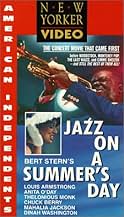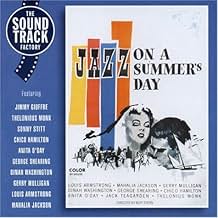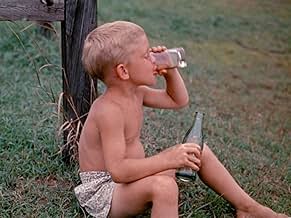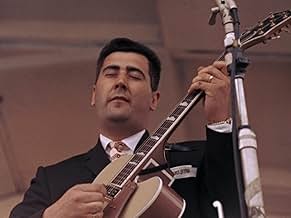VALUTAZIONE IMDb
7,9/10
2084
LA TUA VALUTAZIONE
Aggiungi una trama nella tua linguaThe highlights of the 1958 Newport Jazz Festival.The highlights of the 1958 Newport Jazz Festival.The highlights of the 1958 Newport Jazz Festival.
- Regia
- Sceneggiatura
- Star
- Premi
- 2 vittorie totali
Recensioni in evidenza
This is a wonderful document of the 1958 Newport Jazz Festival and archetype for the concert film, with captivating interludes of visual poetry. As close as one can get to traveling back through time, watching the audience is as much fun here as watching the performers. You can recognize this film as a source of inspiration, perhaps, for the pretensions behind projects like "The Last Waltz," and one certainly gets a sense, given the caliber of the performers gathered onto a single stage, of the magnitude of this event without it ever being forced. The intimacy remains intact. And in contrast with the somber beat of "The Last Waltz," the sun shines on everything here. A joy.
Bert Stern captures the Newport Jazz festival of 1958 in vivid color and with clarity. While jazz is the primary focus of the film, Stern does meander to the America's Cup race that was being contested off Newport at the time, along with some diversionary local flavor, which gives us a sense of what it was like to actually be there. Continuing along this vein, during the festival itself, Stern spends much of his camera time observing the audience caught unaware reacting to jazz on a summer day; after all, live music does not exist in a vacuum. It's this footage along with the incredible jazz music that makes this documentary really special. As a viewer we get to react to the music, and react to the audience reacting to the music. That girl with the seductively cute smile in the yellow dress, and that gruff man hiding behind the shades with the nervous twitch are people that we can connect to from our own personal experiences at open air summer concerts. The feeling of community one gets as the music breaks down the barriers and the sun begins to set. Stern allows his moving compositions to develop and flesh out the character of his subjects, giving us a nostalgic feeling for a time gone by that may have occurred long before we were even born. It does not matter because we are there! But this particular slice of time has special significance, because jazz would soon be replaced in popularity by Rock & Roll. We watch it happen before our eyes as a young Chuck Berry takes the stage. Backed by some excellent jazz musicians, all looking "amused" but not taking very seriously the music that would knock them off the charts for good within a couple of years. As Berry's classic Rock & Roll riffs project across the audience, young people spontaneously jump to their feet and start moving to the rhythm while their parents watch, perplexed.
10tavm
Anita O'Day singing "Sweet Georgia Brown". Dinah Washington warbling "All of Me" while also playing the xylophone. Chuck Berry playing guitar rocking to "Sweet Little Sixteen" while also doing his famous duck walk. Thelonious Monk on the piano. Gerry Mulligan with his band. Louis Armstrong and Jack Teagarden dueting on "Rocking Chair". And Mahalia Jackson ending the program on "The Lord's Prayer". All those I've cited are highlights of what I've seen in this great documentary of the Newport Jazz Festival of 1958 which ran at the same time as the America's Cup boat race of which some of that is also shown. And seeing all those shots of audience members having the time of their lives were also fine visually especially when one was seen singing along with one of Sachmo's songs. The whole thing was an overwhelming treat to watch so all I'll now say is Jazz on a Summer's Day is highly recommended.
An exhilarating bullseye of music and spirit and a masterwork in aesthetics and observation.
Absolutely not a minute is wasted. Every decision of whether to show the performers, the audience, or the moments where it cuts to different scenes around the neighborhood (which could each function as a perfect short film on their own) all feels cohesively motivated in serving as a perfect testament to universal human joy and enthusiasm for creative spirits. The eye for capturing people in unguarded, emblematic moments serves as a fantastic precursor to Monterey Pop and Woodstock (as well as Neil Young's Weld but people aren't ready for that conversation yet) and its spirit was later taken to great effect by Jonathan Demme.
I get the sense that a great deal could be written about the larger cultural contexts that contributed to an object this pure and awesome being preserved, but for me its most inspiring as a testament to sensitive and committed people being on their absolute A-game for every aspect of production. This includes the people behind the camera having an acute sense for the perfect moments and angles to capture (and the showcase of lighting perfection from shot to shot, especially in such a free-form documentary setting, is absolute insanity), to the people responsible for the preservation of the film itself being so rich and beautiful, to the editors having an exacting sense of rhythm and kineticism (and making consistently creative and surprising choices among what must have been an intimidating amount of fantastic footage to curate), to the performers who each and every one of them manage at least one spellbinding and memorable moment (Anita O'Day being a total BEAST of a performer, Chuck Berry using a clarinet player to stunning effect, and Satchmo ascending to god form and winning music are just some of my favorites and I'm sure you'll have your own because every performance serves as a unique, full expression).
I cannot overstate what a revelation this film is, from the performances themselves to the cutaways to the life surrounding the festival, these are transcendent moments that form this fusion of music and image that feel like all of human existence was made in order to converge to this place and time, which is now available immaculately forever.
Absolutely not a minute is wasted. Every decision of whether to show the performers, the audience, or the moments where it cuts to different scenes around the neighborhood (which could each function as a perfect short film on their own) all feels cohesively motivated in serving as a perfect testament to universal human joy and enthusiasm for creative spirits. The eye for capturing people in unguarded, emblematic moments serves as a fantastic precursor to Monterey Pop and Woodstock (as well as Neil Young's Weld but people aren't ready for that conversation yet) and its spirit was later taken to great effect by Jonathan Demme.
I get the sense that a great deal could be written about the larger cultural contexts that contributed to an object this pure and awesome being preserved, but for me its most inspiring as a testament to sensitive and committed people being on their absolute A-game for every aspect of production. This includes the people behind the camera having an acute sense for the perfect moments and angles to capture (and the showcase of lighting perfection from shot to shot, especially in such a free-form documentary setting, is absolute insanity), to the people responsible for the preservation of the film itself being so rich and beautiful, to the editors having an exacting sense of rhythm and kineticism (and making consistently creative and surprising choices among what must have been an intimidating amount of fantastic footage to curate), to the performers who each and every one of them manage at least one spellbinding and memorable moment (Anita O'Day being a total BEAST of a performer, Chuck Berry using a clarinet player to stunning effect, and Satchmo ascending to god form and winning music are just some of my favorites and I'm sure you'll have your own because every performance serves as a unique, full expression).
I cannot overstate what a revelation this film is, from the performances themselves to the cutaways to the life surrounding the festival, these are transcendent moments that form this fusion of music and image that feel like all of human existence was made in order to converge to this place and time, which is now available immaculately forever.
This film really stuck with me, and so I feel compelled to say a few things about it.
It's one of the earliest concert films I've ever seen, and honestly maybe one of the better ones. I say that as someone who likes some jazz sometimes but wouldn't count it among my personal favourite music genres. That being said, the performances here are largely great, and it does a fantastic job of showing why jazz means so much to so many people. It conveys how fun jazz can be, how entertaining its musicians can be, the technical prowess involved, and also how it can be surprisingly moving.
Only a handful of names were familiar to me, but all proved entertaining to watch. Chuck Berry stood out in a slightly jarring way, being more of a rock artist than a jazz artist, but he ended up fitting in well. There's a nice flow to all the performers, I liked how it included the MC introducing them, and I loved the concert's progression from day to night.
In general, the visuals are what elevate this from being a good concert film with entertaining music and performances to a great concert film/ documentary. My favourite part might of been the montage of life in Newport on that day, about halfway through the film- of course it could have been filmed on a different day, but it's such great, hypnotic filmmaking that you don't think about it at the time. Seeing these people dancing, drinking, smoking, especially the people on the roof... it was surprisingly beautiful and moving.
I was born almost 40 years after this concert even took place, but somehow, it still managed to evoke a strong sense of nostalgia. I don't doubt that life was still complicated back then, and there were hardships and tribulations in the same way to how those things exist nowadays. Yet for 80-something minutes, you don't think about that. You're transported into a town that for one summer's day, in 1958, allowed all its citizens to have the time of their lives, and there's something incredibly and unexpectedly beautiful about that, even for a 25-year-old, very casual jazz fan like myself.
I'd recommend this to all fans of concert films and documentaries, or maybe just films in general. I'm happy to see a high score on here, but the low number of ratings is a little saddening. This deserves to be considered at least a minor classic, but even if that never happens, I'm glad I watched it, and am thankful to my grandfather for recommending it; without him, I may have never even heard of it.
It's one of the earliest concert films I've ever seen, and honestly maybe one of the better ones. I say that as someone who likes some jazz sometimes but wouldn't count it among my personal favourite music genres. That being said, the performances here are largely great, and it does a fantastic job of showing why jazz means so much to so many people. It conveys how fun jazz can be, how entertaining its musicians can be, the technical prowess involved, and also how it can be surprisingly moving.
Only a handful of names were familiar to me, but all proved entertaining to watch. Chuck Berry stood out in a slightly jarring way, being more of a rock artist than a jazz artist, but he ended up fitting in well. There's a nice flow to all the performers, I liked how it included the MC introducing them, and I loved the concert's progression from day to night.
In general, the visuals are what elevate this from being a good concert film with entertaining music and performances to a great concert film/ documentary. My favourite part might of been the montage of life in Newport on that day, about halfway through the film- of course it could have been filmed on a different day, but it's such great, hypnotic filmmaking that you don't think about it at the time. Seeing these people dancing, drinking, smoking, especially the people on the roof... it was surprisingly beautiful and moving.
I was born almost 40 years after this concert even took place, but somehow, it still managed to evoke a strong sense of nostalgia. I don't doubt that life was still complicated back then, and there were hardships and tribulations in the same way to how those things exist nowadays. Yet for 80-something minutes, you don't think about that. You're transported into a town that for one summer's day, in 1958, allowed all its citizens to have the time of their lives, and there's something incredibly and unexpectedly beautiful about that, even for a 25-year-old, very casual jazz fan like myself.
I'd recommend this to all fans of concert films and documentaries, or maybe just films in general. I'm happy to see a high score on here, but the low number of ratings is a little saddening. This deserves to be considered at least a minor classic, but even if that never happens, I'm glad I watched it, and am thankful to my grandfather for recommending it; without him, I may have never even heard of it.
Lo sapevi?
- QuizBert Stern, when trying to retrieve his archives from Spain, offered the Schomburg Center for Research in Black Culture, a division of the New York Public Library, all the footage of the film, along with the outtakes, in return for their paying the outstanding $50,000 storage bill and shipping them back to New York.
- Citazioni
Louis Armstrong: I was at a little Italian trumpet player's house, and his mother was a Countess, well they was makin' that spaghetti and we was wailin', you know. In this big ol' dinin' room they had this table and up in the ceilin' they had Mark Anthony and Cleo and all the cats that they painted. Lookin' down on you as if to say, "Man, you shore can eat!"
[laughs]
Louis Armstrong: Well, we have a lot of fun travelin', man.
I più visti
Accedi per valutare e creare un elenco di titoli salvati per ottenere consigli personalizzati
- How long is Jazz on a Summer's Day?Powered by Alexa
Dettagli
Botteghino
- Lordo in tutto il mondo
- 74.811 USD
Contribuisci a questa pagina
Suggerisci una modifica o aggiungi i contenuti mancanti

Divario superiore
By what name was Jazz in un giorno d'estate (1959) officially released in India in English?
Rispondi




































